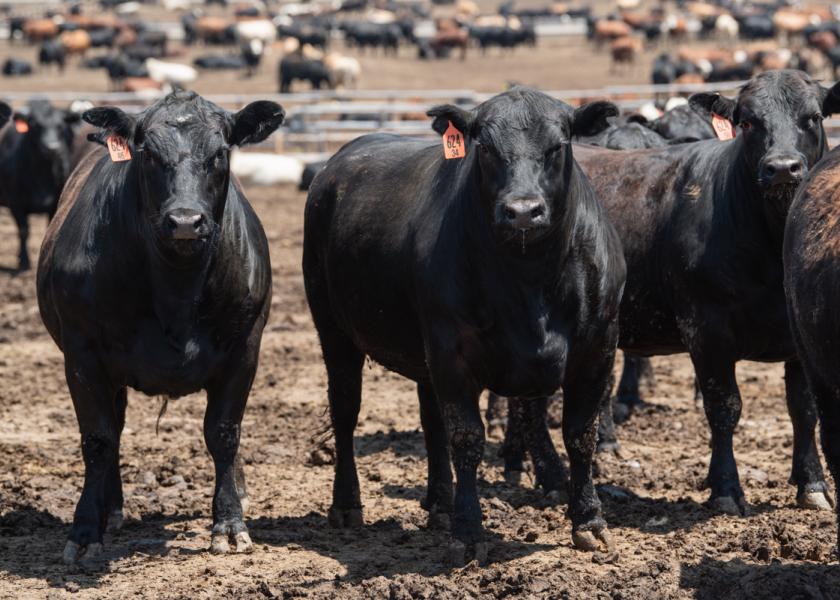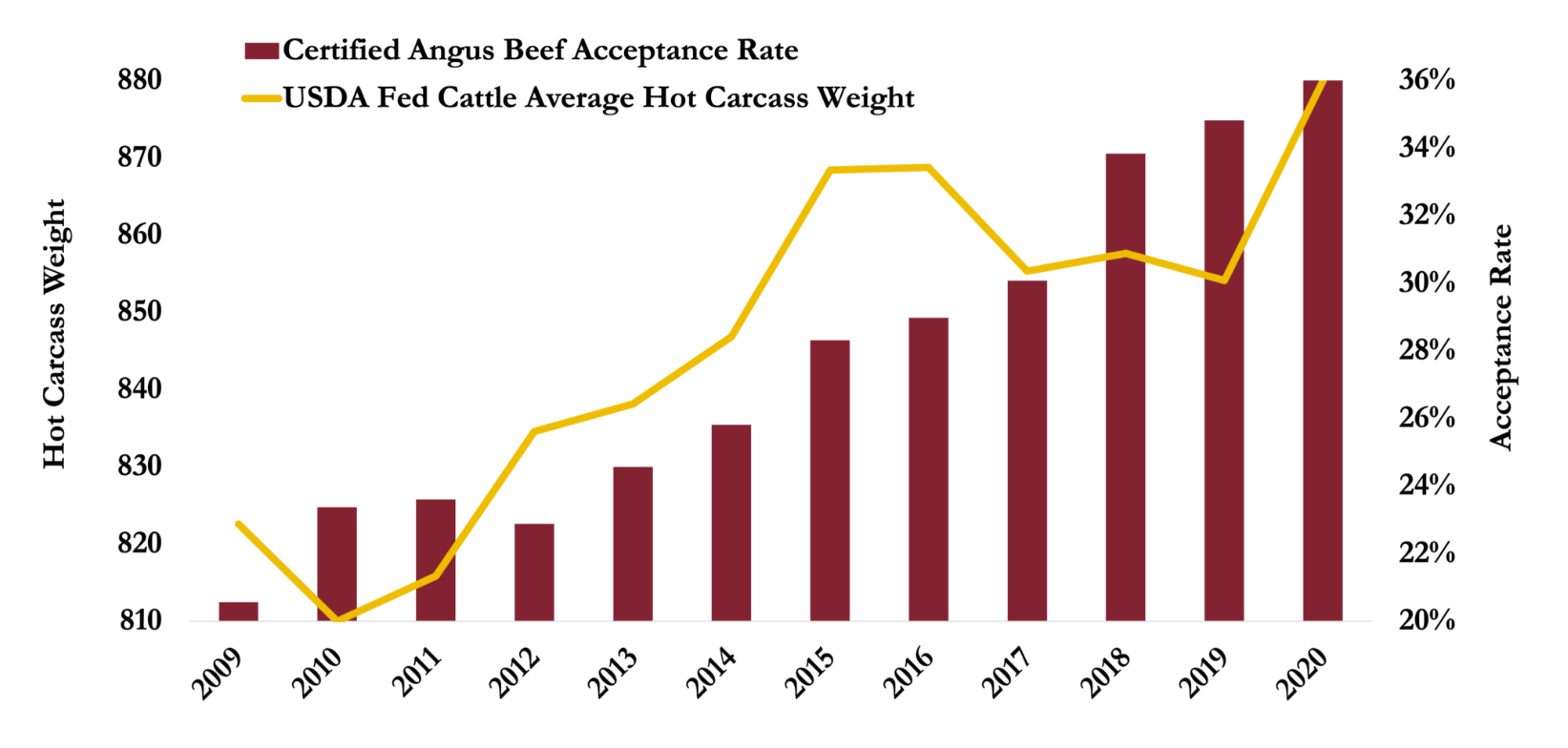Missing the Mark Leaves Money on the Table

Raising cattle to qualify for the Certified Angus Beef (CAB) brand goes far beyond color.
Sure, it starts with a black hide, but then a carcass has to meet all 10 of the brand’s specifications (listed below).
Certified Angus Beef regularly collects data on millions of fed cattle to discover how cattlemen can capture more value for high-quality carcasses beginning on the ranch. Genetic selection and targeted management help create the higher value beef that fills each CAB box.
When black-hided cattle don’t earn the CAB stamp, it’s most often for lack of marbling, followed by hot carcass weight (HCW) above 1,050 lb., ribeye area (REA) exceeding 16 square inches, or more than one inch of backfat.
Lessons from the pandemic still influence how feedyards manage cattle, so it pays to review those adjustments. A backlog of fed cattle in 2020 meant more days on feed (DOF) with subsequent management changes that led to elevated HCW, REA and backfat thickness. Although each of these affect CAB acceptance, the increases had a negative impact on certified headcounts. However, the negative effects were outweighed by greater marbling deposition, which boosted brand acceptance rates overall.
CAB carcasses require a Modest or higher degree of marbling, always the main hurdle to clear for brand acceptance. Until recently, more than 90% of eligible black-hided cattle fell short here. In 2020, the number dropped to near 80% as closed packing plants and backlogged cattle allowed more time for marbling to develop while other disqualifiers gained ground.
“Not only is marbling the single largest reason black-hided cattle fail to qualify,” says Clint Walenciak, CAB senior director of product services, “but it’s also important for consumer satisfaction, taste and a great eating experience.”
Last year saw the richest quality mix among fed cattle, with USDA Prime carcasses reaching an all-time high average of 10%, says Paul Dykstra, CAB director of supply management and analysis. Cattle grading Choice averaged 72% over the last two years.
“In 2021, the average Choice/Select spread was $16.45 per hundredweight (cwt.) with a mid-summer record high of $32,” Dykstra says. The CAB/Choice spread averaged $17 per cwt.
The wide difference in beef prices based on quality grade didn’t deter customers, proving demand for the best beef is strong, Dykstra says. That’s a clear message for ranchers to keep focusing on marbling in their herds along with other relevant traits.
In 2020, the number of cattle excluded from CAB for surpassing the maximum REA, HCW and/or backfat nearly doubled. Historically, HCW increased nearly 6 lb. per year, a consistent rise driven by genetics as well as seasonal production patterns, Walenciak says.
When HCW increased nearly 25 lb. from 2019 to 2020, the percentage of cattle excluded from the brand solely due to HCW above 1,050 lb. jumped from 3.8% to 7.7%.
“In the spring, anywhere from late April to early May, we’re going to see the lowest carcass weights of the year from calf-feds,” Walenciak says. “Late October to early November is most likely when we’re going to see the seasonal peaks.”
Within that seasonal ebb and flow, HCW recently varied 70 lb., compared to 40 to 50 lb. a decade ago. As HCW peaks, CAB acceptance rates drop, Walenciak says. “We really see that HCW sweet spot for brand acceptance at 850 to 900 lb.”
Carcasses can be excluded from CAB for missing multiple specs. Marbling improves with more DOF, but REA and fat can reach levels that kick them out of CAB. That fact creates a challenge for feedyards aiming to find balance in DOF. The pandemic emphasized this struggle, yet continued to show more marbling tends to outweigh reductions caused by missing the brand’s next three requirements.
The effects reach beyond brand impacts. Heavier finished cattle also increased yield grade (YG) 4 and 5 carcasses. As of October 2021, combined YG 4s and 5s were roughly double the percentage produced in 2011, Dykstra says.
“As the market-ready fed cattle supply becomes more current, expected later this year, average DOF should decline,” he says. That means wider price spreads favoring high-quality beef and an increasing producer share in carcass cutout values.
In other words, as the fed cattle market continues toward normal, selection and management to raise cattle that fit premium beef programs still pays. That’s seen in the $3.4 million paid in CAB premiums to producers each week.
The data says you’ve made progress in the quest for quality, but there’s still room—and incentive—for improvement there and in management to produce the best carcass.
10 Specifications to Become Certified Angus Beef
A predominantly black hide is just the first hurdle to CAB eligibility, but it’s what’s under it that seals the deal. Only a third-party or USDA grader determines that.
The 10 Certified Angus Beef brand specifications:
1. Modest or higher marbling
2. Medium to fine marbling texture
3. Only A-maturity and less than 30 months of age by dentition
4. 10- to 16-square-inch ribeye area
5. 1,050-pound or less hot carcass weight
6. 1 inch or less fat thickness
7. Superior muscling
8. Practically free of capillary ruptures
9. No dark cutters
10. No neck hump exceeding 2 inches
The moment of truth is in the packinghouse cooler, but the journey starts at conception on the ranch. The right genetics play a big part in whether a calf has the carcass potential to meet these specs. The other parts of the equation are environment and management to ensure they never have a bad day.










